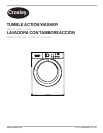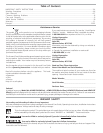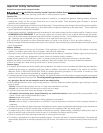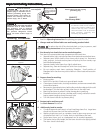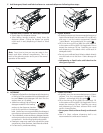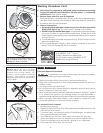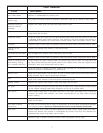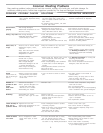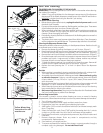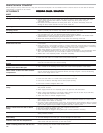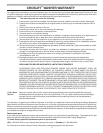
8
Blue stains
Discoloration,
graying
Greasy, oily stains
Holes, tears, or
snags
Lint
Pilling
(Fibers break off,
ball up and cling to
fabric.)
Residue or
powder on dark
items;
Stiff, harsh
fabrics.
Wrinkling
Yellow buildup of
body soil on
synthetic fabrics
Yellow or brown
rust stains
•Undiluted liquid detergent or
fabric softener dispensed directly
onto fabric.
•Not enough detergent.
•Wash water temperature too low.
•Incorrect sorting.
•Not enough detergent.
•Undiluted liquid fabric softener
poured directly on fabric.
•Incorrect use of chlorine bleach.
•Unfastened zippers, hooks,
buckles.
•Rips, tears and broken threads.
•Overloading the washer.
•Degradation of fabric.
•Incorrect sorting.
•Tissues left in pocket.
•Overloading the washer.
•Not enough detergent.
•Undissolved detergent has left
a residue resembling lint.
•Static cling is attracting lint.
•Load washed too long.
•Pilling is normal with synthetic
and permanent press fabrics.
This is due to abrasion from
normal wear.
•Undissolved detergent.
•Some granular detergents can
combine with hard water
minerals to form a residue.
•Overloading the washer.
•Overloading the washer.
•Incorrect wash cycle for wash
load.
•Agitation time too short.
•Wash water temperature too low.
•Not enough detergent.
•Iron or manganese in water
supply, water pipes, or water
heater.
•If caused by detergent, mix 1 cup (240
ml) white vinegar with 1 quart (.95 L)
water in a plastic container. Soak item 1
hour. Rinse.
•If caused by fabric softener, rub stains
with bar soap. Wash.
•Rewash with correct amount of
detergent and hottest water safe for
fabric. Add bleach safe for fabric.
•Treat with prewash stain remover or
liquid detergent.
•Increase detergent and water
temperature. Rewash.
•Rub fabric softener stains with bar soap.
•May be irreversible if rips, tears and
seams cannot be mended.
•Reduce load size. Rewash using correct
water temperature, water level, and
amount of detergent.
•Add nonprecipitating water conditioner
to wash water to remove detergent
residue.
•Add liquid fabric softener to final rinse.
•Dry load in dryer.
•Remove lint with lint brush or roller.
• Use a lint brush or shaver to remove
pills.
•Rewash load.
•Reduce load size.
•Rinse in cold water with liquid fabric
softener using the Perm Press or
Delicate cycle.
•Soak in detergent booster or product
containing enzymes.
•Wash in hot water using full permanent
press cycle. Increase detergent.
Add bleach safe for fabric.
•Or, treat with color remover.
•To restore discolored load of whites,
use rust remover safe for fabric.
•Do not use chlorine bleach to remove
rust stains. It may intensify discoloration.
•Avoid overfilling detergent and fabric
softener compartments of dispenser.
•Sort items by soil level and color.
•Use correct amount of detergent, hottest
water and bleach safe for fabric.
•Use correct amount of detergent and
hottest water safe for fabric.
•Do not pour liquid fabric softener directly
on fabric. See Washing Procedures for
directions on adding softener.
•Never pour chlorine bleach directly on
fabric.
•Check condition of items before washing.
See Washing Procedures for preparing
and loading the wash load and adding
chlorine bleach.
•See Washing Procedures for sorting and
preparing the wash load.
•Do not overload washer.
•Use correct temperature and amount of
detergent, water and wash time.
•Use fabric softener in the washer to
lubricate fibers.
•When ironing, use spray starch or fabric
finish on collars and cuffs.
•Turn items inside out to reduce abrasion.
•Increase water temperature using hottest
water safe for fabric.
•Do not overload washer.
•Use liquid detergent or use nonprecipitating
water conditioner with granular detergent.
•Do not overload washer.
•Remove items from washer as soon as
cycle is completed.
•Use liquid fabric softener.
•Select correct wash cycle.
•Use correct amount of detergent.
•Wash synthetics frequently using hot or
warm water.
•Use nonprecipitating water softener.
•Before washing, run hot water for a few
minutes to clear lines.
•Drain water heater occasionally.
•For an ongoing problem, install an iron filter
in your water supply system.
Common Washing Problems
SOLUTIONSPROBLEM PREVENTIVE MEASURESPOSSIBLE CAUSES
Many washing problems involve poor soil and stain removal, residues of lint and scum, and fabric damage. For
satisfactory washing results, follow these suggestions provided by The Soap and Detergent Association.



